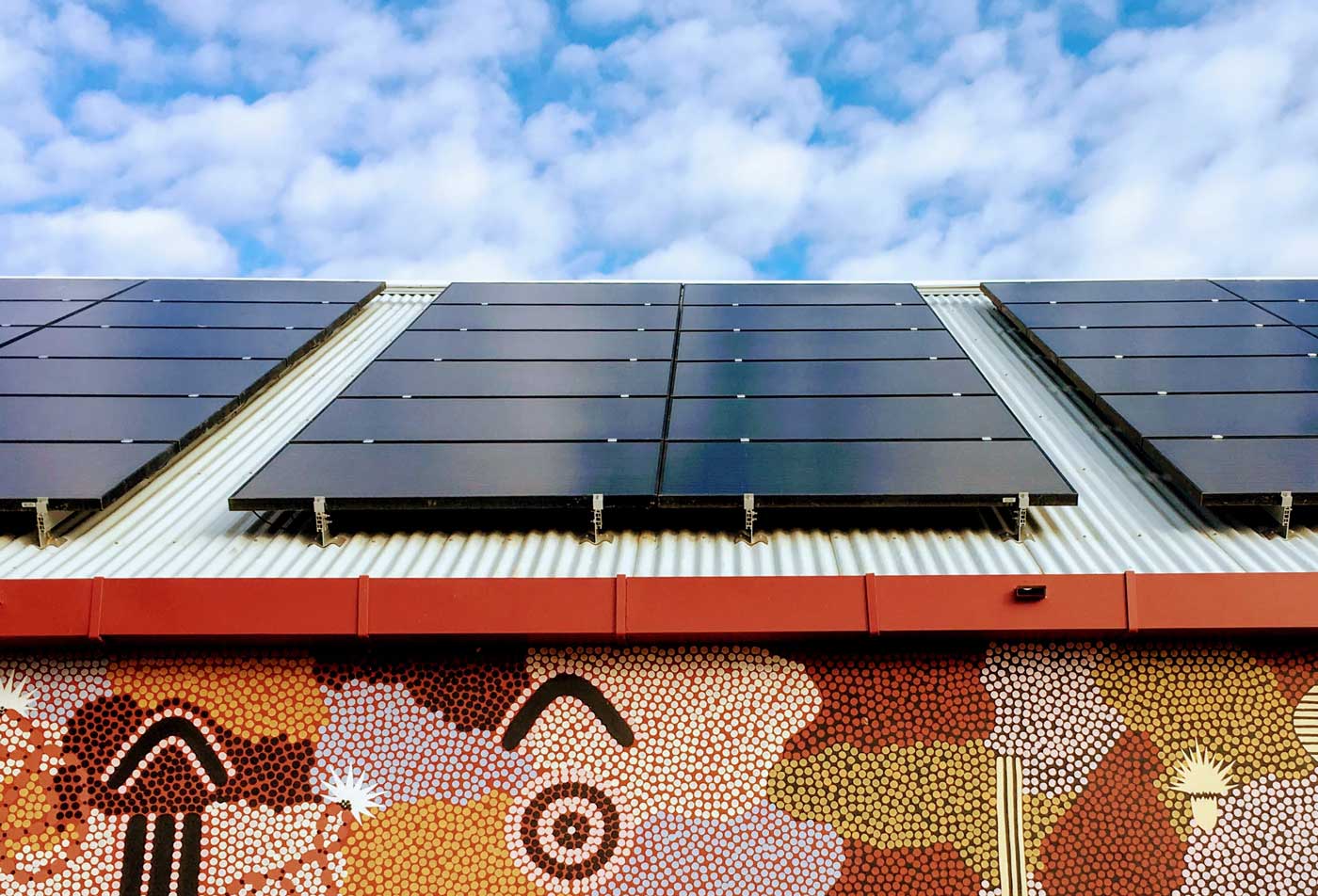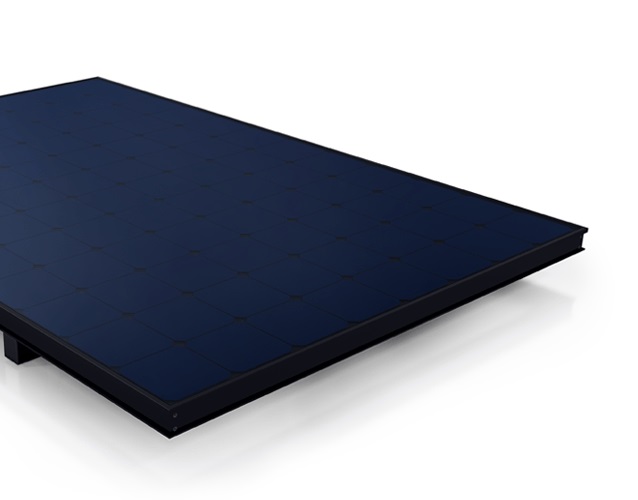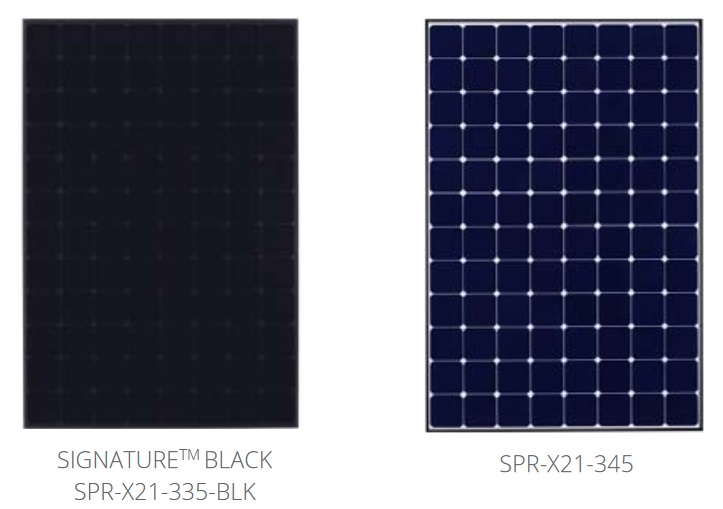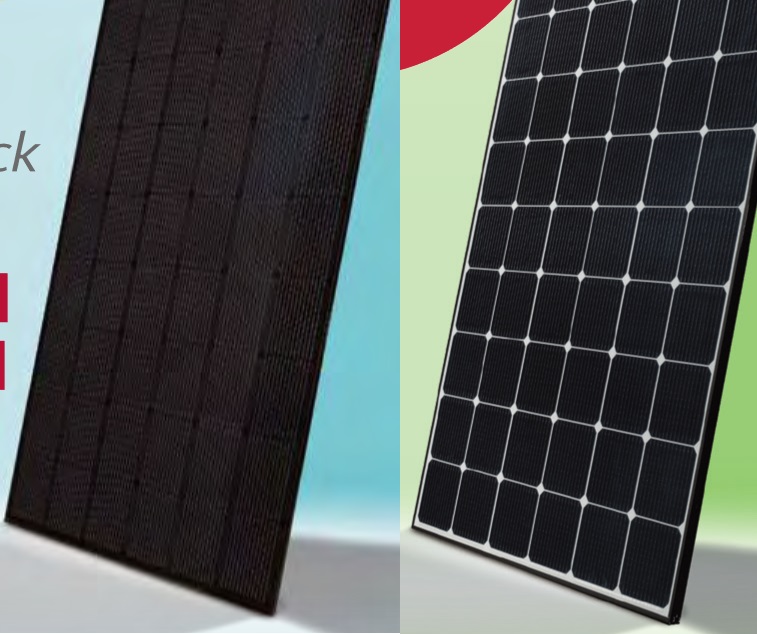
Black solar panels in Alice Springs. Black frame, black cells, black backsheet. Photo Credit: Finn
Black Solar Panels Are Hot! This Reduces Efficiency.
I want you to think about someone you know who has rooftop solar. It doesn’t matter who. It could be a friend, a relative, or that handsome bearded man you’ve been stalking for months — it doesn’t matter. I want you to think about where they live. Picture their home in your mind’s eye and then answer these two questions:
- Do you have any idea what their solar panels actually look like?
- Do you give a damn what their solar panels look like?
I am going to guess you answered “no” to at least one of those questions. With maybe a few rare exceptions, the only people who care about your solar panels’ appearance are you and the people selling them to you. The few others who may care are probably nutters who are best avoided. Personally, I’m kind of obsessed with solar panels. I eat ground up solar panels for breakfast, but I still don’t care what yours look like. I will notice if they have been installed incorrectly, but as far as I am concerned looks don’t matter as long as they reliably do their job of converting photons of light into electricity.
But the majority of humans are terribly self conscious creatures and think that other people are actually going to care what their solar panels look like. I’m pretty self conscious myself. I always brush my beard before checking my horse in the morning even though the only person likely to see me is the stalker hiding in the bushes. We spend so much time worrying about what other people think of us we spend very little time actually thinking about other people. Ironic, isn’t it?1
One group of people who take advantage of humanity’s basic social paranoia are salespeople. Admittedly, when it comes to things like clothes and deodorant, they may be right about other people caring, but solar panels aren’t in your face or up your nose holes. They’re on your roof and people simply don’t pay much attention to them. However, manufacturers know people are paranoid about appearances and so a number produce panels they claim are more pleasing to the eye than average ones. Right now there is only one common method of making panels look different from the majority and that is producing black panels.
Black & Blue
There are two main types silicon used in solar cells. Polycrystalline cells have multiple crystals and look blue while slightly more efficient. More expensive monocrystalline cells are cut from a single large crystal and are very dark. While they’re not quite black, they are close to it. Solar cells are normally placed on a white backsheet, which creates a grid of white lines around them. But when dark monocrystalline cells are placed on a black backsheet it is difficult to distinguish the grid from the cells and so it creates a “black” solar panel.
Three Main Points
If you like the look of black panels and want to put them on your roof that’s fine with me. I’m not writing this article to try to stop you. I’m writing it so you can approach buying black solar panels with your eyes open and be aware of the following:
- Apart from you, almost no one cares what your panels look like.
- Solar panels may not be not visible from the ground.
- You will be paying for a product that is slightly worse than an otherwise identical standard panel.
Beautiful Black SunPower Panels
Here is a close up of a black SunPower panel I stole from their American website:
As you can see, it’s pretty dark. Dark like a German fairy tale. If you slapped them on the roof of a gingerbread house they would look like this:
Provided an obscene amount of effort was put into making the gingerbread resemble an American house.
Here are SunPower’s black and standard versions of their X-series panels with their full, fancy, technical looking names underneath them:
The three digit numbers in those names — 335 and 345 — are how many watts the panels are rated to produce. As you can see the black one produces 10 watts less than the standard solar panel. So under identical conditions the black panel will provide around 3% less energy. Here’s a table showing their differences in wattage and efficiency:
The only difference I am aware of between these two panels is the black backsheet and I’m pretty sure making it dark isn’t going to make it cheaper, so you’ll have to pay at least the same price, which means you will be getting less per dollar spent compared to the standard panel with a white backsheet.
LG Solar’s NeON 2 Black Solar Panels
Here is a picture showing LG Solar’s NeON 2 black panel and their standard NeON 2 panel:
The SunPower panels above don’t have busbars on the surface of their solar cells because they use N-type cells with interdigitated rear contact. But if you look carefully at the LG panels you can see that, while they also have N-type cells, they have fine wires on their surface. They are difficult to make out because the panels are quite intentionally tilted to make them less obvious. You know what else is normally tilted? Solar panels mounted on roofs. Just as the busbars are hard to see, from a distance the white lines on a standard solar panel can also be hard to see.
As with the SunPower X-Series panels, the black NeON 2 Black panel does not perform as well as its white backsheet brother:
Both types of panels have a 315 and 320 watt version, but if you look at the module efficiency you’ll see it is less for the black panels. So how can the black panels have the same wattage if they are less efficient? Simple — both the solar cells and the entire panel are larger in the black versions. While they are only 4.4% larger this can definitely result in less of them fitting on a roof.
The NeON 2 Black panels do have one advantage. The Pmax figure is -0.37% rather than -0.38%. This is a measure of how much the panel’s efficiency decreases by for each 1 degree increase in panel temperature over 25 degrees. It’s not a huge advantage because even in the middle of a massive heatwave the black solar panel will only produce about half a percent more electricity than the standard one, but that’s better than no benefit.
Black Backsheets Are Bad For Efficiency
A black backsheet is a bad choice from the point of view of efficiency because the hotter solar panels get the worse they perform and in sunlight black gets hotter than white. So the gaps between solar cells on a panel with a black backsheet will absorb heat instead of reflecting it. These gaps will get hotter than the solar cells because the cells convert a portion of solar energy falling on them into electrical energy that gets conducted away, but the gaps don’t do this. So panels with black backsheets are always likely to perform worse than white backsheet ones. At least until they work out a way to make the gaps generate electricity.
Panels that are made up of small overlapping solar cells, such as SunPower’s P-Series or Seraphim’s Eclipse, do eliminate a lot of gaps, but they don’t get rid of all of them and using a black backsheet, as Seraphim does, results in the same problem. Just not as bad.
Panels May Not Be Visible From The Ground
I’m certain you wouldn’t be this silly, but some people have selected solar panels based on their appearance without first checking to see if they will be visible from the ground. If you are thinking about paying extra for panels based on how they look, please don’t forget to check the section of roof they are going on is clearly visible.
For Efficiency I’m Telling You Little White Lines
Deng Xiaoping once said:
"只要它捕捉老鼠,一只猫是黑色还是白色并不重要。"“It doesn’t matter if a cat is black or white, as long as it catches mice.”
I wish I could say black backsheets allowed solar panels to catch photons as well as white ones, but they don’t. If you buy black panels you will pay more, either up front through a higher price or through lower efficiency. But if your desires are black then when the darkness calls you may be more than willing to pay the price to see those somber panels clamped to your roof without a trace of little white lines. Your call.
Footnotes
- This is a serious question. I don’t actually know what the word ironic means. Alanis Morissette and I have been trying to work it out for years. ↩







 RSS - Posts
RSS - Posts



The black panels absorb more heat.
I noticed my Trina panels produce more KWH on a cool day rather than a stinking 40 degree day so I can imagine the black panels suffer even more.
I think you missed the point on what they look like. Having been involved in the building game for 45 years and lately have noticed a total clash of shapes of an irregular shape of a very expensive roof shape made look like crap with these things slapped on top. Gable roofs or some of the newer skillion roofs can look okay if they are placed in a regular pattern while others should go on the shed or a stand out the back-
I ended up with those LG Neon 2 (non-black) panels as a middle ground, as they have black frames and look a whole lot prettier to my eyes than blue panels with silver frames. They happen to perform very well, too; the ones mentioned in the article may be an older model as mine produce 330w each. They seem to lose about 10% efficiency in heat waves, which I imagine is fairly normal and not something to dread like the PTSD-inducing horror of cloudy days.
I agree that outsiders have better things to do than worry about the appearance of panels, but the same is generally true of cars and many other products. (Unless you drive an FSM Niki 650. Then people will be very concerned, as they should be.)
The difference is that a more aesthetic roof may have implications for home resale values; to the right buyer, this additional value (or, rather, the lack of lost value) could mean more than the entire cost of the solar panel system, particularly in light of typical house prices in major cities. The interested party looking at your house might be a coal lobbyist who flies into a violent fit of rage at the mere sight of solar set-ups, but if the panels are hidden in a veil of darkness there is a chance of them not noticing and purchasing the house anyway.
Maybe there are arguments to be made in terms of subtle mental health benefits in maximising the aesthetics of one’s home environment, too. Then again, I am one of the silly people you mention who paid extra for more attractive panels that are barely visible from the road.
I am waiting about five more years before replacing or adding to my array with the newfangled ‘bifacial’ panels that have no backsheet, and therefore will render this argument moot.
Yeah…. I’ve heard of Deng Xiaoping. Isn’t he the same bloke who said:- “If at first you don’t succeed get a bigger hammer”?
Quite possibly. Either that or “…blame it on the gang of four.”
We dislike the black panel, however we had to have it, as the solar company no longer stocked the white backing one.
Thanks to little so-and-so’s with bad educations and nothing to do but watch famous, renovation programs, we all have to put up with this $hite that looks awful.
Just like every place on telly that they touch ends up looking like a metrosexual bachelor pad, so does what was my nice white roof. Shame! Foisting other people’s taste on us isn’t good business!
Actually solar cell manufacturers don’t like to supply black panels too. Normally when you texture the mono-crystalline cells, there will be a colour gap among the cells from dark blue to black. As you can’t 100% print cells with only one colour in manufacturing process, so when everyone buys only black colour cells there will be a lot of dark blue cell stocks piled up there. Normally black colour cell consist only 20~30% of your overall output. And due to PV market is over-supplied now, these stock’s price will only drop every week if you let it there.
Thanks for the article Ronald. We have a residential block with a 40 metre frontage – We have quite a wide house at around 35m and the house is cut into the block meaning you are literally looking at the roof from the street, it’s in your face. Whilst we’re open to white backed panels we’re concerned the thing will look like an in your face solar farm as all the panels would be on the roof facing the street. The roof is pretty much level with the road. If we were going black what would your recommendation be as the most efficient. It’s a very dark concrete tile roof (charcoal) so in our situation we are seriously considering going the black. Cheers – Chris
The loss in efficiency from using black panels is very small and the extra cost is only a few cents per watt, so if black panels is what you want then go for it. I think that, because most people don’t pay much attention to roofs, you will mostly be doing it for yourselves, but there is nothing wrong with that.
Good news is, even with black panels, your home should be much cooler in summer with solar panels covering a large portion of your charcoal roof.
Thanks for the reply Ronald, much appreciated, food for thought. When you turn into our street our roof is looking at you as our place is right on the bend at the end of a small straight. It’s either blend them in or it’s ‘wow they’ve got panels’ as our front yard and road is level with our roof. I’ll get some quotes and be happy with whatever we decide. Either way we’re on a winner I spose…..cheaper bills! Thanks again
I just came across this article…
The panel wattage and module efficiency you see on a datasheet is measured under Standard (Flash) Test Conditions (25 degree cell temp). Obviously a flash of light doesn’t give the cells or panel enough time to be affected by heat.
The difference in wattage between the two SunPower models has nothing to do with the colour of the backsheet.
Cells are flash tested before they get made into panels. The cells are then sorted based on their output. Lower wattage cells are grouped together and made into lower wattage panels. And higher wattage cells are made into higher wattage panels. No different to any other panel model that has different watt-classes.
The reality is, the losses from a black backsheet are negligible. In fact, higher efficiency cells (like SunPower and LG) are converting more sunlight into electricity and *less into heat*. They also have industry-leading Temperature Coefficients.
And the irony is, those sneaky manipulative salespeople who you claim “take advantage of humanity’s basic social paranoia” are probably using this SolarQuotes article to convince customers to buy their cheap blue panels with silver frames, “because black panels are less efficient”
Many people are living stealthily in their vans due to the housing market crash rendering many of them homeless, and there are others who voluntarily enjoy the van life as some sort of trend or cost-savings option, and then there are those living in RVs, Outlanders, Skoolies, Shuttles, Ambulance/Fire Truck/Breadtruck Conversions, etc. — all of whom would prefer to keep their solar panels discreet and less tempting to car thieves. There are also those who live in tiny homes where the roof is much more obviously exposed. There’s already enough stigma with many of these lifestyles, so the less attention drawn, the better.
If your approach is : “Looks don’t matter”, you’re probably right. I’m an architect specialising on sustainable architecture, and I believe there is an important balance to be held between beauty and performance – or form and function. I would argue that over 70% of solar panels are very very visible and half of them are installed and procured in a way that pays total disregard to the architecture that they form part of – which to me (and everyone conscious of design) is pretty terrible.
Not saying black is always the right answer , but balance is important – so please always look at both sides of the medal. And sometimes, yes, black is the right answer (here’s an example from our recently completed work – the ‘biophilia’ house, where any solar panel other than black would have been an insult to the home : https://melbournedesignstudios.com.au/2020/03/07/hunting-for-george/ )
I disagree. When I see architecture where function is compromised by form it is fundamentally ugly to me. Compromising a solar panel’s efficiency by using black back sheet is an example. Houses without eaves is another one. Black bricks in most Australian climates is a third.
As a person of exquisite aesthetic taste, I would say if ever there was a building crying out for burnt seinna solar panels, it would be that home.
Had our (single level) house re-roofed with black terracotta tiles – very visible from the street.
We then added 34 LG NeOn2 Black 330 panels (with Enphase micro-inverters). We think it looks great, and we’ve had many positive comments from neighbours and passers-by….. definitely has added aesthetic value to the place.
As a bonus, when the panels were installed, and with them covering the majority of the roof, we also noticed a significant reduction in radiant heat ingress. The solar panels are helping keep the house noticeably cooler, just by shading the roof.
Peter B.
Is the price of aesthetics worth it, Peter?
Ronald’s post above begins with the sub heading “Black Solar Panels Are Hot! This Reduces Efficiency.”
So, over the operating life of your black panels, your system will be generating less energy compared with standard panels.
Also, darker roofs are significantly hotter than lighter roofs. In cooler climes, where heating requirements of the building dominate, darker roofs can be beneficial. However, in hotter climates, where cooling requirements dominate, darker roofs (even with insulation or sarking) increase energy demand and cost more to maintain comfort levels.
Then there’s the longer-term consideration of climate change.
In a Dec 2018 The Fifth Estate article headlined “The truth about dark roofs and cooler roofs”, it includes:
“Houses built now might not be prepared for the climate change affected temperatures of the future. The publication says that it would be prudent to look at projected temperatures over the 50-80 year lifetime of a house, with CSIRO research predicting temperatures up to 4°C warmer on average by 2100.”
https://www.thefifthestate.com.au/innovation/residential-2/the-truth-about-dark-roofs-and-cool-roofs/
And from the ABC in Oct 2017:
“Australia is hot. But future extreme hot weather will be worse still, with new research predicting that Sydney and Melbourne are on course for 50 degrees Celsius summer days by the 2040s if high greenhouse emissions continue.
That means that places such as Perth, Adelaide and various regional towns could conceivably hit that mark even sooner.”
https://www.abc.net.au/news/2017-10-06/50-degree-days-what-would-sydney-and-melbourne-look-like/9024914
If you are in a colder area, like Tassie, alpine regions or Canberra, the “added aesthetic value” might be worth it. Elsewhere, I think not.
Thanks for your question Geoff,
So to summarise what we’ve achieved:
– We Generate 3.7 times as much energy as we Consume,
– We Export 3.2 times as much energy as we Consume,
– On hot days, our house is noticeably cooler than it used to be – simply from the shading provided by the panels,
– The house looks GREAT… black panels on a black roofed red-brick house, in a leafy (very green) setting just looks beautiful,
– Oh, and our power bill went from $2,500 per annum down to $175 per annum (Red Energy), planning to move to Powershop as that will reduce it by a further $200.
So, YES, the aesthetics, and the whole project has been VERY worthwhile.
Thanks for the article.
I understand the arguments for and against black backing when only considering the sun facing side of the panel.
My question is, ‘does a black backing on the rear of a ground mounted panel increase thermal radiation and therefore add to the cooling off there panel?’
I say ground mounted because they are likely to have a greater air cooling capacity than roof mounted.
Your thoughts please…
Well, according to Kirchoff’s Law of Thermal Radiation:
https://en.wikipedia.org/wiki/Kirchhoff%27s_law_of_thermal_radiation
All else equal panels with black backs should radiate more heat. But Kirchoff’s Law of Thermal Radiation should be called Kirchoff’s Law Does Not Actually Apply In Reality. It is an idealized statement and actual results will depend on the actual materials used. I would guess putting a black coating on the backsheet of a solar farm panel would result in it being slightly cooler than one without a black coating. Whether it would be worth the extra expense, I don’t know. All I can say is, not counting backsheets that are all black, no manufacturer seems to be doing it.
Some of the people don’t no what they are talking about i am staying in south Africa the temp here is 32 degrees celcuis to 45 a 360watt polly panel make the same power as a 400watt mono panel in summer here you can touch a polly panel but you can’t touch a mono panel and a black car is hotter inside than a blue car so if heat kills power how can a panel that absorb more heat make more power than a panel that absorbe less heat
The black panels look much nicer than ones with ugly aluminum-colored frames. Also, all premium black panels are more efficient, because they are manufactured with a monocrystalline structure vs polycystalline structure as found in blue panels.